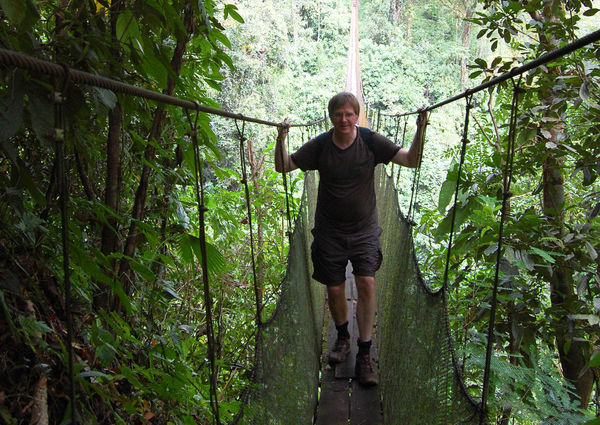The Nature of Travel in Costa Rica
By Rick Steves
January 2009
When I want to take a vacation, I don't go to Europe. I work in Europe — so I try to take vacations elsewhere. Recently my family and I spent a week in Costa Rica. I'd never been to Central America to simply relax, and I was clueless about Costa Rica. I just signed up for the best eight days that my friend's tour company could offer.
For someone who knows so much about travel, it was fun being clueless. I couldn't even find where we were going on the map. Not knowing what plugs worked, I needlessly brought European adapters. I was paranoid that our iPhone would be on accidentally, and we'd be roaming 24/7, racking up a huge bill, and sipping cheap drinks while going broke.
At the small San Jose airport, we climbed into a tiny, six-seater plane for a herky-jerky ride over lush mountains. Our destination was a jungle landing strip and then a quick shuttle to the remote beach at Manuel Antonio National Park. The flight seemed pretty dangerous. I kept looking at the pilot and his young co-pilot, who were incredibly nonchalant as they flew their airborne jalopy into a dense cloud, managing to push the right little buttons and switches as the entire cockpit rattled away in a complete whiteout. Eventually, like a stray chunk of two-lane highway, our landing strip came into view. The "nature" vacation was about to begin.
When I'm in Europe, I like fancy culture: music, art, and history. For me (while I love being in and enjoying nature), learning about flora and fauna ranks near the bottom, just above geology and genealogy. But in Costa Rica, I was on a steep learning curve in the best classroom I could imagine for getting turned on to plants and critters — this remote national park on the Pacific Coast.
Walking under a jungle canopy one day, I heard rustling and looked up. A troop of white-faced capuchin monkeys swung by like a class of grade-school Tarzans out on a field trip, their tails gripping branches as dexterously as their arms. Suddenly, the "alpha male" broke off a branch and threw it down, as if to remind us, "No one mates with any of these monkeys but me. Bop juh wah wah wah."
Later, our guide Pablo explained how termites contribute to the finely tuned ecosystem, eating only dead wood. (The bad news: houses are made out of dead wood — that's one reason why you won't find many old houses around here.) The termites' smell keeps other insects away, so monkeys smear them on their fur — giving "bug juice" a whole new spin. Then, popping one into his mouth, Pablo reminded us that termites are also full of nutrition...if bitter.
In the jungle, dark, furry balls hang like stuck basketballs high in the canopy. They are sloths, which literally sleep away most of their lives. They rest upside-down so well that they are even found dead just hanging from their favorite branch.
The agouti, Costa Rica's second biggest rodent (at up to 20 inches long) is a "planter" — it steals fruits and nuts, digs a hole, and buries them. As they generally forget to come back to eat their stash, they spend their lives unknowingly planting lots of trees. That makes them everyone's favorite rodent.
Nature is great at deception and camouflage. A butterfly wing attracts a mate with a stunning, iridescent blue on one side, and scares away predators by looking like a snake's head on the other. A plant called a rattlesnake tail is tastier than it looks. And lizards sit as still as knotholes, looking like the bark of trees they hang out on.
Here, on this narrow isthmus, in what locals call the healthiest ecosystem in Central America, this hemisphere's vast variety of life is funneled and condensed into a narrow stretch of land. There's nothing like this in Europe. The leading industry is getting tourists to come down here to enjoy nature. Their big theme is wisely "eco-friendly."
Back at the lodge, I felt as if I were living in a teak treehouse. The jungle tumbled to a green horizon — everything seemed to reach for the sun. I felt thankful to be so alive. I looked up and saw a V-shaped line of birds. They were in formation with Blue Angels–like precision, as if to remind human visitors — especially urbanite Europhiles like me — that there is a powerful, all-knowing, respect-deserving order in nature.

